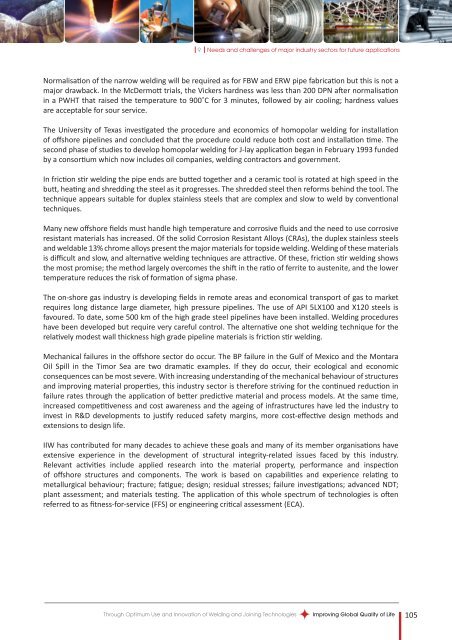Improving Global Quality of Life
Improving Global Quality of Life
Improving Global Quality of Life
You also want an ePaper? Increase the reach of your titles
YUMPU automatically turns print PDFs into web optimized ePapers that Google loves.
9 Needs and challenges <strong>of</strong> major industry sectors for future applications<br />
Normalisation <strong>of</strong> the narrow welding will be required as for FBW and ERW pipe fabrication but this is not a<br />
major drawback. In the McDermott trials, the Vickers hardness was less than 200 DPN after normalisation<br />
in a PWHT that raised the temperature to 900˚C for 3 minutes, followed by air cooling; hardness values<br />
are acceptable for sour service.<br />
The University <strong>of</strong> Texas investigated the procedure and economics <strong>of</strong> homopolar welding for installation<br />
<strong>of</strong> <strong>of</strong>fshore pipelines and concluded that the procedure could reduce both cost and installation time. The<br />
second phase <strong>of</strong> studies to develop homopolar welding for J-lay application began in February 1993 funded<br />
by a consortium which now includes oil companies, welding contractors and government.<br />
In friction stir welding the pipe ends are butted together and a ceramic tool is rotated at high speed in the<br />
butt, heating and shredding the steel as it progresses. The shredded steel then reforms behind the tool. The<br />
technique appears suitable for duplex stainless steels that are complex and slow to weld by conventional<br />
techniques.<br />
Many new <strong>of</strong>fshore fields must handle high temperature and corrosive fluids and the need to use corrosive<br />
resistant materials has increased. Of the solid Corrosion Resistant Alloys (CRAs), the duplex stainless steels<br />
and weldable 13% chrome alloys present the major materials for topside welding. Welding <strong>of</strong> these materials<br />
is difficult and slow, and alternative welding techniques are attractive. Of these, friction stir welding shows<br />
the most promise; the method largely overcomes the shift in the ratio <strong>of</strong> ferrite to austenite, and the lower<br />
temperature reduces the risk <strong>of</strong> formation <strong>of</strong> sigma phase.<br />
The on-shore gas industry is developing fields in remote areas and economical transport <strong>of</strong> gas to market<br />
requires long distance large diameter, high pressure pipelines. The use <strong>of</strong> API 5LX100 and X120 steels is<br />
favoured. To date, some 500 km <strong>of</strong> the high grade steel pipelines have been installed. Welding procedures<br />
have been developed but require very careful control. The alternative one shot welding technique for the<br />
relatively modest wall thickness high grade pipeline materials is friction stir welding.<br />
Mechanical failures in the <strong>of</strong>fshore sector do occur. The BP failure in the Gulf <strong>of</strong> Mexico and the Montara<br />
Oil Spill in the Timor Sea are two dramatic examples. If they do occur, their ecological and economic<br />
consequences can be most severe. With increasing understanding <strong>of</strong> the mechanical behaviour <strong>of</strong> structures<br />
and improving material properties, this industry sector is therefore striving for the continued reduction in<br />
failure rates through the application <strong>of</strong> better predictive material and process models. At the same time,<br />
increased competitiveness and cost awareness and the ageing <strong>of</strong> infrastructures have led the industry to<br />
invest in R&D developments to justify reduced safety margins, more cost-effective design methods and<br />
extensions to design life.<br />
IIW has contributed for many decades to achieve these goals and many <strong>of</strong> its member organisations have<br />
extensive experience in the development <strong>of</strong> structural integrity-related issues faced by this industry.<br />
Relevant activities include applied research into the material property, performance and inspection<br />
<strong>of</strong> <strong>of</strong>fshore structures and components. The work is based on capabilities and experience relating to<br />
metallurgical behaviour; fracture; fatigue; design; residual stresses; failure investigations; advanced NDT;<br />
plant assessment; and materials testing. The application <strong>of</strong> this whole spectrum <strong>of</strong> technologies is <strong>of</strong>ten<br />
referred to as fitness-for-service (FFS) or engineering critical assessment (ECA).<br />
Through Optimum Use and Innovation <strong>of</strong> Welding and Joining Technologies<br />
<strong>Improving</strong> <strong>Global</strong> <strong>Quality</strong> <strong>of</strong> <strong>Life</strong><br />
105
















